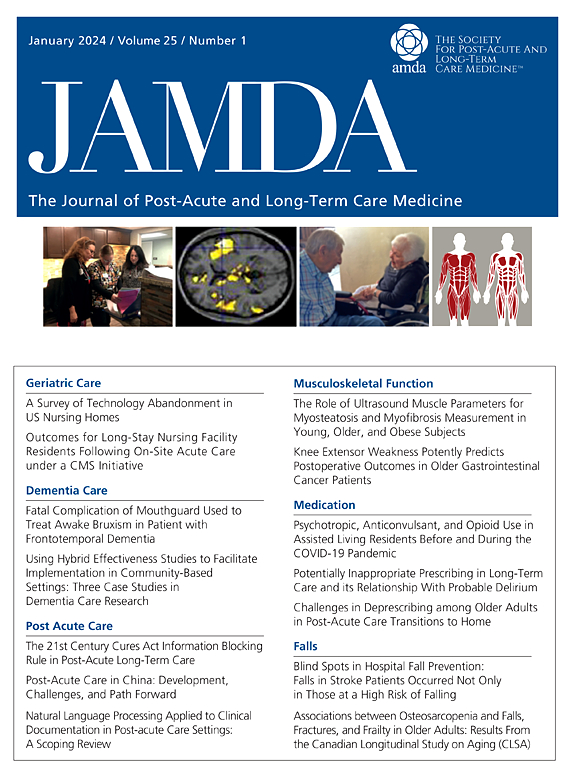Care Trajectories for a Cohort of First-Time Nursing Home Admissions: A 5-Year Longitudinal Study in Minnesota
IF 3.8
2区 医学
Q2 GERIATRICS & GERONTOLOGY
Journal of the American Medical Directors Association
Pub Date : 2025-10-09
DOI:10.1016/j.jamda.2025.105885
引用次数: 0
Abstract
Objectives
This study modeled 5-year care trajectories of first-time, dual-eligible older adults admitted to Minnesota nursing homes (NHs), capturing discharges to the community, NH readmissions, hospitalizations, and mortality. A secondary aim was to examine associations between care trajectories and dementia, baseline cognitive function, and demographic, clinical, and functional profiles.
Design
Retrospective cohort study.
Setting and Participants
We analyzed 9853 older adults first admitted to Minnesota NHs in 2015 and followed them for up to 60 months. Minimum Data Set were linked to Medicaid claims from the Minnesota Medicaid Management Information System.
Methods
Latent class growth analysis identified trajectories based on monthly NH stay, hospitalization, and community stay, with mortality treated as a discrete time survival outcome. Dementia was included as a binary covariate. Resident characteristics across trajectories were compared using bivariate analyses and multinomial logistic regression.
Results
The following 4 distinct trajectories were identified: (1) trajectory 1 (early mortality with continued NH use, 38%) experienced shortest survival, highest NH utilization, and peak hospitalizations in year 1; (2) trajectory 2 (steady return to long-term NH care, 11%) had longer survival and frequent hospitalizations in years 2 and 3, ultimately spending 90% of time alive in NHs by year 5; (3) trajectory 3 (transitional care with multiple moves, 22%) had better survival and longer community stays but the most transitions, with increased NH use over time; and (4) trajectory 4 (short stay then return to community, 29%) experienced best outcomes with longest survival, minimal NH readmissions, and few hospitalizations. Trajectories were significantly associated with baseline differences in cognitive function, physical dependency, and sociodemographic characteristics.
Conclusions and Implications
Care trajectories among dual-eligible NH residents are highly heterogeneous. Although 38% remained in NHs until death, 29% sustained community living, and 33% experienced frequent transitions. These patterns underscore the need for individualized care planning and system-level strategies to meet complex, evolving needs.
护理轨迹的队列第一次疗养院入院:在明尼苏达州的5年纵向研究。
目的:本研究模拟了首次进入明尼苏达州养老院(NHs)的双重资格老年人的5年护理轨迹,包括出院到社区,NH再入院,住院和死亡率。第二个目的是研究护理轨迹与痴呆、基线认知功能、人口统计学、临床和功能概况之间的关系。设计:回顾性队列研究。环境和参与者:我们分析了9853名2015年首次进入明尼苏达州NHs的老年人,并对他们进行了长达60个月的随访。最小数据集与明尼苏达州医疗补助管理信息系统中的医疗补助索赔相关联。方法:潜在类别增长分析确定了基于每月NH住院时间、住院时间和社区住院时间的轨迹,死亡率被视为离散时间生存结局。痴呆被纳入二元协变量。使用双变量分析和多项逻辑回归比较了不同轨迹的居民特征。结果:确定了以下4种不同的轨迹:(1)轨迹1(持续使用NH的早期死亡率,38%)的生存时间最短,NH利用率最高,第1年住院率最高;(2)轨迹2(稳定回归长期NH护理,11%)在第2年和第3年有更长的生存时间和频繁的住院治疗,最终在第5年在NHs中度过了90%的生存时间;(3)轨迹3(多次移动的过渡性护理,22%)有更好的生存率和更长的社区停留时间,但大多数过渡,随着时间的推移,NH的使用增加;(4)轨迹4(短期停留然后返回社区,29%)的最佳结果是生存时间最长,NH再入院率最低,住院率最低。轨迹与认知功能、身体依赖和社会人口学特征的基线差异显著相关。结论和启示:双重资格的NH居民的护理轨迹是高度异质性的。虽然38%的人一直留在NHs直到死亡,29%的人维持社区生活,33%的人经历了频繁的转变。这些模式强调了个性化护理规划和系统级战略的必要性,以满足复杂的、不断变化的需求。
本文章由计算机程序翻译,如有差异,请以英文原文为准。
求助全文
约1分钟内获得全文
求助全文
来源期刊
CiteScore
11.10
自引率
6.60%
发文量
472
审稿时长
44 days
期刊介绍:
JAMDA, the official journal of AMDA - The Society for Post-Acute and Long-Term Care Medicine, is a leading peer-reviewed publication that offers practical information and research geared towards healthcare professionals in the post-acute and long-term care fields. It is also a valuable resource for policy-makers, organizational leaders, educators, and advocates.
The journal provides essential information for various healthcare professionals such as medical directors, attending physicians, nurses, consultant pharmacists, geriatric psychiatrists, nurse practitioners, physician assistants, physical and occupational therapists, social workers, and others involved in providing, overseeing, and promoting quality

 求助内容:
求助内容: 应助结果提醒方式:
应助结果提醒方式:


